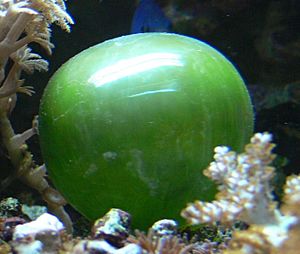Bubble algae facts for kids
Quick facts for kids Valonia ventricosa |
|
|---|---|
 |
|
| Scientific classification | |
| Kingdom: | |
| Phylum: | |
| Order: |
Siphonocladales
|
| Family: |
Valoniaceae
|
| Genus: |
Valonia
|
| Species: |
V. ventricosa
|
| Binomial name | |
| Valonia ventricosa J.Agardh 1887.
|
|
Valonia ventricosa, often called "bubble algae" or "sailors’ eyeballs", is a unique type of algae. You can find it in oceans all over the world, especially in tropical and subtropical areas. It's famous for being one of the largest single-celled organisms on Earth! Even though it's just one cell, it has many nuclei inside.
Contents
Meet the Sailor's Eyeball!
Where Does it Live?
Valonia ventricosa usually grows by itself, but sometimes you might see small groups of them. They live in shallow coastal areas and on the continental shelf in warm, tropical, and subtropical waters. This includes places like the Caribbean, stretching north to Florida and south to Brazil. You can also find them across the Indo-Pacific region. They live in most of the world's oceans, often making their home among broken coral pieces. The deepest they've been found is about 80 meters (260 feet) underwater.
What Does it Look Like and How Does it Grow?
This amazing single-celled organism is shaped like a sphere or an egg. Its color can be anything from bright grass green to a very dark green. If it lives in very deep, dark water, it might even look silver, teal, or almost black! The color depends on how many chloroplasts (the parts that make food from sunlight) it has. Its surface often looks shiny, like glass.
The "bubble" is a tough, thin-walled cell that can be anywhere from 1 to 4 centimeters (0.4 to 1.6 inches) wide. In rare cases, it can grow even bigger, up to 5.1 centimeters (2 inches)! This bubble algae attaches itself to the ocean floor using tiny, hair-like parts called rhizoids. These small anchors give it a surprisingly strong grip!
Valonia ventricosa reproduces through a process called cell division. The main cell, which has many nuclei, creates smaller "daughter" cells. These new cells then break away and grow into their own separate bubble algae.
Why Do Scientists Study It?
Because its cells are so big, Valonia ventricosa is very useful for scientists. They use it to study how things pass through cell membranes. Think of a cell membrane like a tiny gate that controls what goes in and out of a cell.
Scientists have also used Valonia ventricosa to study the cellulose (a tough material) in its cell wall. They use special X-ray tests to learn more about its structure. This algae is also interesting because of its electrical properties. It has a much higher electrical charge inside compared to the seawater around it, which scientists find fascinating to research.
Images for kids
-
Valonia ventricosa in the Red Sea
See also
 In Spanish: Valonia ventricosa para niños
In Spanish: Valonia ventricosa para niños


